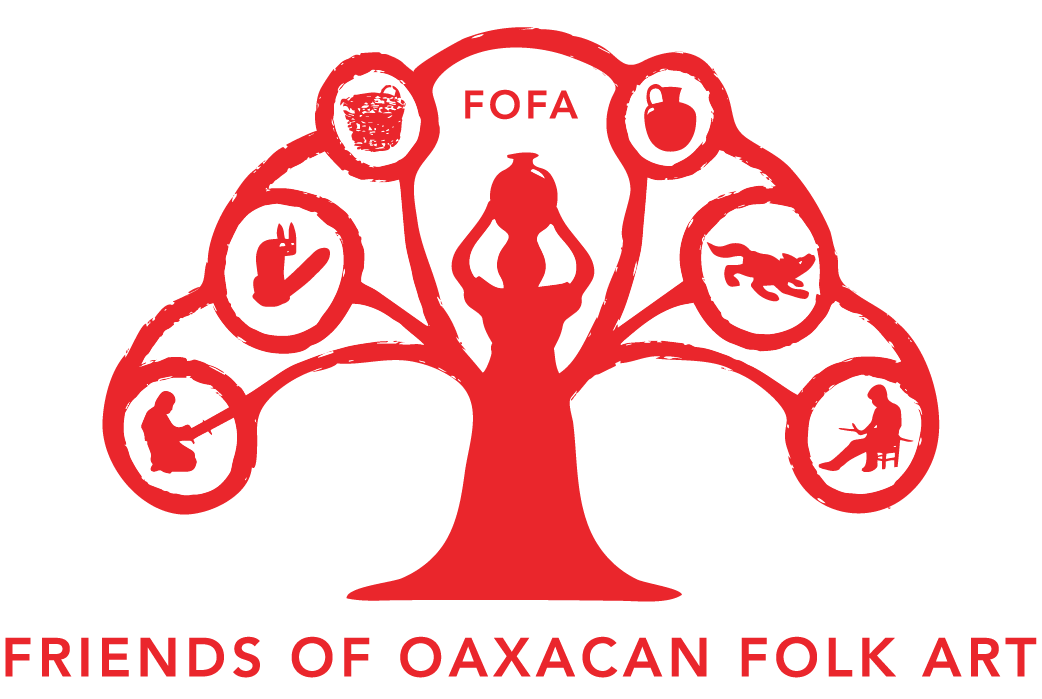MEET THE ARTISTS
CORN HUSK FIGURES
The ArtisTS
Unlike most of the folk art and handicrafts of Oaxaca, cornhusk figures were introduced within the last 30 to 40 years. Most artisans who create complex pieces in this modality indicate they are first generation. However, simpler pieces, e.g., flowers and small figures in regional costumes sold as souvenirs at market stands may have been introduced earlier.
Mariana Ayala Bautista
[Honorable mention, FOFA 2013 contest]
Pueblo of San Juan de Dios Etla (about 1 hour from Oaxaca City)
Avenida Reforma #5
b.bautista10@hotmail.com
(From US) Landline: 011-52-953-533-0741
Cell: 011-52-951-272-3276
(In Oaxaca) Landline: 533-0741
Cell: 951-272-3276
Mariana learned to create cornhusk art (totomoxtle) at the age of 11. For FOFA’s 2013 young artists’ competition, she decided to make a circular piece to convey both the form and the cyclical quality of the earth, where everything is born, reproduces itself, and dies. She explained that she has included representations of all that is found on Mother Earth: water, plants, and animals. Humans are represented by corn, the sacred source of nurture that nature has contributed since the time of her ancestors. Mariana regards Mother Earth in the image of a woman who perpetually gives life to and protects her children.
Florentino Ramón Navarro Pérez
[Honorable Mention in Other Modalities, FOFA’s 2016, 2022 contests]
Calzada del Toro #4, San Sebastián Tutla 71246
(To call from US, first dial 011-52)
Tel celular • Cell phone: 951-123-7525
Tel de casa • Landline: 951-688-0205
Email: tinofly552@gmail.com
Facebook: Piel de maiz
Instagram: piel_de_maiz
Ramón had never seen corn husk art until his early 20s when his parents, who run a tiny provisions shop, took him to the city’s annual Night of the Radishes festival on December 23rd. Here artists who carve radishes and create cornhusk sculptures compete for prizes. Ramón was enchanted. Motivated, he took brief courses in painting and drawing and within three years he won second place in the city’s competition. His piece “Jarabe del Valle” portrays a popular regional Oaxacan dance that exudes happiness. Ramón is meticulous in creating his dancers, right down to the ties on their sandals and ornamentation of their jewelry.
The Sosa Family
Moisés Ruíz Sosa
[Winner, FOFA’s 2016 contest; Honorable mention, FOFA’s 2013 contest]
Oaxaca City
Cesar A. Ruíz #114, Colonia del Maestro
moses85@live.com.mx
(From US): Cell: 011-52-951-437-7608
(In Oaxaca) Cell: 951-437-7608
Moisés learned to work artistically with cornhusks from his mother, with whom - together with his sister -- he sold their handcrafted dolls, flowers and jewelry as street vendors. After his first art competition, FOFA’s 2013 event at which he was awarded an honorable mention, he began to focus on sculptural works of art in totomoxtle, in addition to beginning training as an architect. He finds cornhusks to be an excellent medium for creating sculptures because of the many textures they afford. This piece, for which he won first place in FOFA’s 2016 contest, represents a fusion between the Spanish and indigenous influences embodied in the Dance of the Devils from Santiago Juxtlahuaca, a very dramatic dance with many elements. Moisés’s figure speaks to both his cultural roots and his dreams. As an artist he wishes to convey that all of us have an interior identity, as well as a separate, external one.
Antonio Sosa Cruz
[Honorable mention, FOFA’s 2016 contest]
Oaxaca City
Abraham Castellanos #209, Colonia del Maestro
antoniososcruz@gmail.com
(From US): Cell: 011-52-951-246-6462
(In Oaxaca) Cell: 951-246-6462
Antonio, now a practicing physician, learned totomoxtle at the age of 16 from his cousins, Marco and Moisés (FOFA’s 2016 first place winner in this category). Antonio’s cornhusk of a devil with an owl mask seizes the viewer’s imagination with its sense of movement and drama. He explained, “In our culture we do not condemn the devil. Perhaps he represents unbridled emotions, and the owl guarded ones, two sides of ourselves we embrace. In the countryside people speak about the devil almost as a friend, someone who travels with them, who is portrayed in dances, on altars, and in paintings.”








